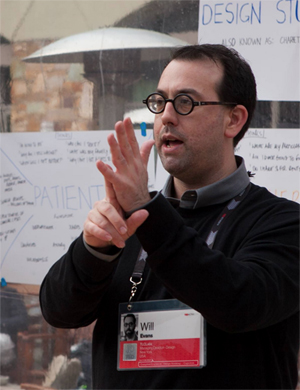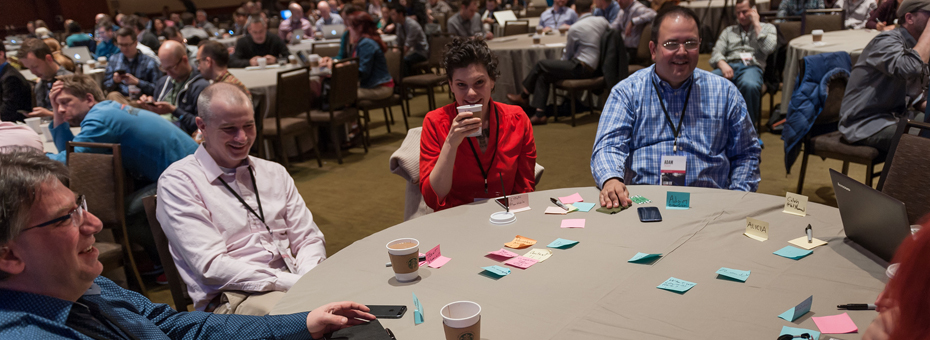At this year’s LeanUX NYC conference (April 15-19), LEI’s John Shook will give a talk, “Lean is About Building an Organization That Learns to Learn.” LeanUX NYC brings together leading minds to teach “how organizations incorporate Lean Systems, Agile, Design Thinking, and DevOps to deliver real value for customers and drive top-line growth.” I sat down with conference creator Will Evans to talk about the purpose of the conference, who attends, and what business and organizational problems it’s intended to solve.
 LEI: What is the purpose of LeanUX NYC?
LEI: What is the purpose of LeanUX NYC?
Will Evans: The purpose is twofold. One, it’s to bring leading thinkers and practitioners in product and process design together to discuss how to create sustainable learning organizations that support teams and people while producing more humane, valuable, useful software – software that, in Drucker’s words, “creates a customer.” On another level, it’s about bringing people together across sectors and value streams so that ideas from one community can seed new knowledge in another. I’m inspired by a quote from John Stuart Mill, who said, “It is hardly possible to overrate the [value of] placing human beings in contact with persons dissimilar to themselves, with modes of thought and action unlike those with which they are familiar.”
I’ve noticed that conferences are representative of the internal silos we construct by discipline. Marketing people have their conferences, designers and engineers have theirs, DevOps (that emergent community that is just now gaining some traction) have theirs. It’s like the conference circuit has become a manifestation of Conway’s Law: “organizations which design systems … are constrained to produce designs which are copies of the communication structures of these organizations.”
If nothing else, interesting things happen when different disciplines rub up against each other. We hope to break down some walls between communities, spark conversation, and perhaps even create a platform where more understanding and empathy can be shared between people who are ultimately all responsible for the creation and delivery of value.
How has the LeanUX conference evolved over the last few years?
The LeanUX NYC conference has always been designed like an lean experiment. Since day one we’ve followed lean methods of formulating a customer hypothesis, problem hypothesis, and solution hypothesis and have used experiments to test our assumptions. We’ve slowly grown in scale and purpose. Initially we were really just interested in exploring Lean Startup and LeanUX principles and methods in an Agile context – but eventually realized this wasn’t giving us enough of the whole picture. It didn’t address enough of the problems organizations really faced, and we realized we were just creating another tribe – another community of practice shut off from other disciplines. This is why this year, we not only cover the entire value stream, but we’ve gone up a level to bring strategy deployment and naturalistic decision making into the program. It’s also why the conference is single-track. Tracks tend to create little shtetls – ghettos where developers attend talks about TDD for instance, UX designers attend talks only in their discipline, and rarely is there overlap. I think this just reinforces existing mindsets, which is neither healthy nor helpful.
What problems does the conference solve and/or aim to solve?
Well, there are no lack of problems worth solving, but with the conference, we’ve tried to just focus on three. First, many organizations face an ever-increasing amount of uncertainty, risk, and competition. I don’t think most are well-equipped to meet those challenges. I think our audience is looking for new ideas, principles, and tools to guide them. We aim to provide people with some.
Second, over the past 10 years or so, we’ve seen the emergence of Agile, Lean Startup, and LeanUX as ideologies meant to help teams overcome adversity to build and release better products. But in my opinion, they aren’t really scalable. They weren’t developed to address the problems of the entire organization – usually just the product development team, so we’re still faced with silo’d thinking and handoffs which creates misunderstandings, waste, and cultures of blame.
Finally, even through Lean Startup and LeanUX have “Lean”, in their name, they don’t really draw on the rich history of Lean Thinking that came out of TPS. Lean with a capital L actually was designed to scale across the organization, with its focus on what John Shook calls the fractal nature of PDSA to create a learning organization from the individual to the team all the way up to the executive suite. That combined with Hoshin, or strategy deployment, creates a cohesive purpose across the enterprise so that people can directly align what they are working on today with the strategic intent of the company.
Having coached these techniques with my partner Jabe Bloom inside of Fortune 50 companies (that aren’t in manufacturing), I can tell you this stuff is hugely valuable. I think the emerging communities of Lean Startup, LeanUX, and DevOps, have a lot to learn from the Lean Thinking community. It’s one of the reasons we’ve connected with LEI and are trying to bring these communities together.
What problems in the UX industry does the conference aim to solve?
The software industry, specifically the Enterprise software industry faces a lot of challenges. Big, wicked problems, as Richard Buchanan might say. Increased complexity, uncertainty, waste… Increased competition. Mountains of technical debt and legacy systems that inhibit teams from moving as quickly as nimble new startups. Hiring, training, and retaining talent. The thing is, as Jim Morgan wrote recently, “excellence in product development is not “an engineering thing”; it’s an enterprise thing,” and yet the tools provided to us by Agile or LeanUX were never, and will never be able to be applied across the entire enterprise. They were local optima to serve local problems. This is really hard work.
Companies are struggling to exploit their existing value streams and explore new ones, and seem to be doing a poor job at both. They’re incredibly busy, but no one knows what people are working on or why. Who can blame them when they have no shared understanding of their mission and don’t visualize work! Who can blame them when people are 100% utilized, people are busy putting out fires, and executives have a sneaking suspicion they have a couple of arsonists on their payroll. Or when few managers are open enough to look in the mirror and realize that they might be the problem.
I don’t know that any one management methodology, be it Agile, or LeanUX, or Lean, offers a silver bullet. I do think bringing people together from different communities of practice and disciplines – to engage in dialogue, unpack methods, and then go back to the gemba – and run safe-to-fail experiments is a good place to start. I think creating learning organizations that are focused on continuous improvement in both product and process design is a good thing to do. Who knows where things can go from there.






